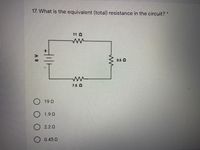
Principles of Physics: A Calculus-Based Text
5th Edition
ISBN: 9781133104261
Author: Raymond A. Serway, John W. Jewett
Publisher: Cengage Learning
expand_more
expand_more
format_list_bulleted
Concept explainers
Question

Transcribed Image Text:17. What is the equivalent (total) resistance in the circuit? *
11 2
0.5 2
7.5 2
19 0
1.9 Q
O 2.2 0
0.45 Q
Expert Solution
This question has been solved!
Explore an expertly crafted, step-by-step solution for a thorough understanding of key concepts.
Step by stepSolved in 2 steps with 2 images

Knowledge Booster
Learn more about
Need a deep-dive on the concept behind this application? Look no further. Learn more about this topic, physics and related others by exploring similar questions and additional content below.Similar questions
- When an unknown resistance Rxis placed in a Wheatstone bridge, it is possible to balance the bridge by adjusting to be 2500 . What is Rxif R2R1 = 0.625?arrow_forward(a) What is the terminal voltage of a large 1.54-V carbon-zinc dry cell used in a physics lab to supply 2.00 A to a circuit if the cell’s internal resistance is 0.100 ? (b) How much electrical power does the cell produce? (c) What power goes to its load?arrow_forwardA child’s electronic toy is supplied by three 1.58-V alkaline cells having internal resistances of 0.0200 in series with a 1.53-V carbon-zinc dry cell having a 0.100- internal resistance. The load resistance is 10.0 . (a) Draw a circuit diagram of the toy and its batteries, (b) What current flows? (c) How much power is supplied to the load? (d) What is the internal resistance of the dry cell if it goes bad, resulting in only 0.500 W being supplied to the load?arrow_forward
- When resistors with different resistances are connected in parallel, which of the following must be the same for each resistor? Choose all correct answers, (a) potential difference (b) current (c) power delivered (d) charge entering each resistor in a given time interval (e) none of those answersarrow_forwardConsider the circuit shown in Figure P28.21 on page 860. (a) Find the voltage across the 3.00-0 resistor, (b) Find the current in the 3.00-12 resistor.arrow_forwardCalculate the power delivered to each resistor in the circuit shown in Figure P21.43. Figure P21.43arrow_forward
- A heart defibrillator passes 10.0 A through a patient’s torso for 5.00 ms in an attempt to restore normal beating, (a) How much charge passed? (b) What voltage was applied if 500 J of energy was dissipated? (c) What was the path’s resistance? (d) Find the temperature increase caused in the 8.00 kg of affected tissue.arrow_forwardThree identical 60.0-W, 120-V lightbulbs are connected across a 120-V power source as shown in Figure P28.72. Assuming the resistance of each lightbulb is constant (even though in reality the resistance might increase markedly with current), find (a) the total power supplied by the power source and (b) the potential difference across each lightbulb.arrow_forwardA heart defibrillator passes 10.0 A through a patient’s torso for 5.00 ms in an attempt to restore normal beating. (a) How much charge passed? (b) What voltage was applied if 500 J of energy was dissipated? (c) What was the path's resistance? (d) Find the temperature increase caused in the 8.00 kg of affected tissue.arrow_forward
- Consider the circuit shown in Figure P21.39. Find (a) the current in the 20.0- resistor and (b) the potential difference between points a and b. Figure P21.39arrow_forwardTo what value must you adjust R3to balance a Wheatstone bridge, if the unknown resistance Rxis 100 , R1is 50.0 , and R2is 175 ?arrow_forwardWhen resistors with different resistances are connected in series, which of the following must be the same for each resistor? Choose all correct answers, (a) potential difference (b) current (c) power delivered (d) charge entering each resistor in a given lime interval (e) none of those answersarrow_forward
arrow_back_ios
SEE MORE QUESTIONS
arrow_forward_ios
Recommended textbooks for you
 Principles of Physics: A Calculus-Based TextPhysicsISBN:9781133104261Author:Raymond A. Serway, John W. JewettPublisher:Cengage Learning
Principles of Physics: A Calculus-Based TextPhysicsISBN:9781133104261Author:Raymond A. Serway, John W. JewettPublisher:Cengage Learning Physics for Scientists and EngineersPhysicsISBN:9781337553278Author:Raymond A. Serway, John W. JewettPublisher:Cengage Learning
Physics for Scientists and EngineersPhysicsISBN:9781337553278Author:Raymond A. Serway, John W. JewettPublisher:Cengage Learning Physics for Scientists and Engineers with Modern ...PhysicsISBN:9781337553292Author:Raymond A. Serway, John W. JewettPublisher:Cengage Learning
Physics for Scientists and Engineers with Modern ...PhysicsISBN:9781337553292Author:Raymond A. Serway, John W. JewettPublisher:Cengage Learning College PhysicsPhysicsISBN:9781938168000Author:Paul Peter Urone, Roger HinrichsPublisher:OpenStax College
College PhysicsPhysicsISBN:9781938168000Author:Paul Peter Urone, Roger HinrichsPublisher:OpenStax College Physics for Scientists and Engineers, Technology ...PhysicsISBN:9781305116399Author:Raymond A. Serway, John W. JewettPublisher:Cengage Learning
Physics for Scientists and Engineers, Technology ...PhysicsISBN:9781305116399Author:Raymond A. Serway, John W. JewettPublisher:Cengage Learning

Principles of Physics: A Calculus-Based Text
Physics
ISBN:9781133104261
Author:Raymond A. Serway, John W. Jewett
Publisher:Cengage Learning

Physics for Scientists and Engineers
Physics
ISBN:9781337553278
Author:Raymond A. Serway, John W. Jewett
Publisher:Cengage Learning

Physics for Scientists and Engineers with Modern ...
Physics
ISBN:9781337553292
Author:Raymond A. Serway, John W. Jewett
Publisher:Cengage Learning

College Physics
Physics
ISBN:9781938168000
Author:Paul Peter Urone, Roger Hinrichs
Publisher:OpenStax College

Physics for Scientists and Engineers, Technology ...
Physics
ISBN:9781305116399
Author:Raymond A. Serway, John W. Jewett
Publisher:Cengage Learning
